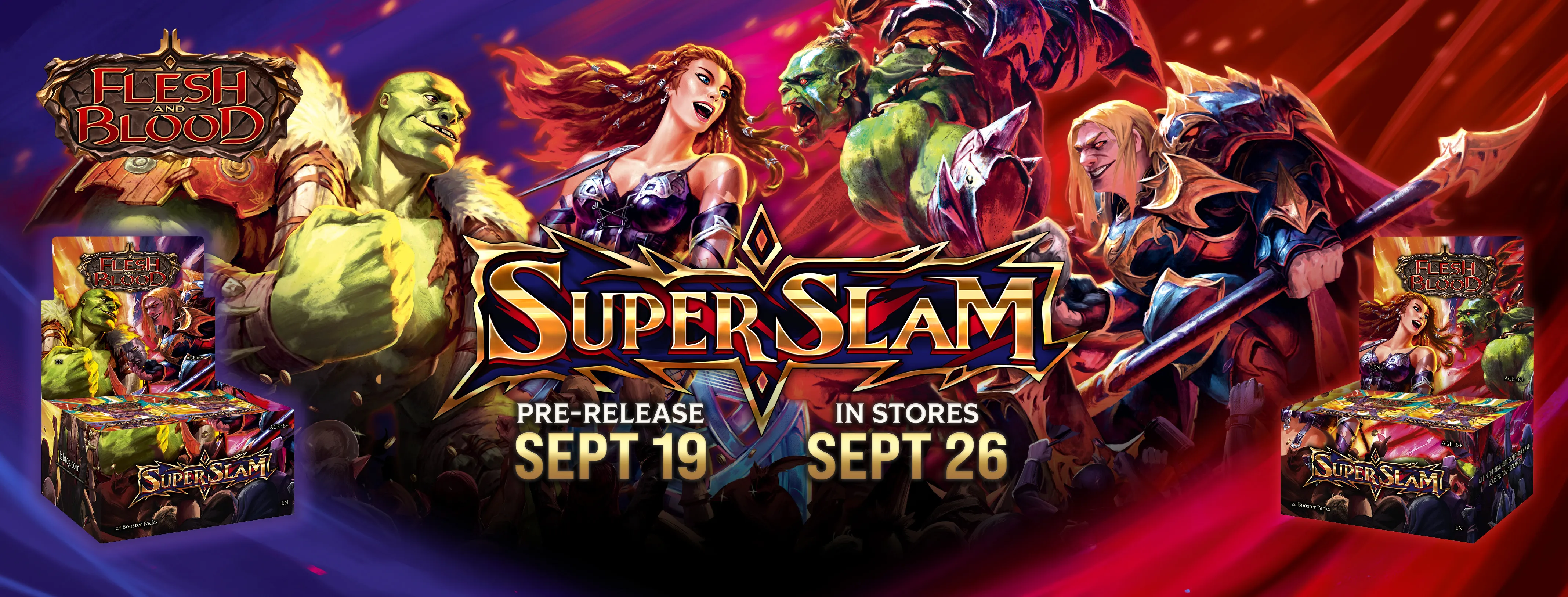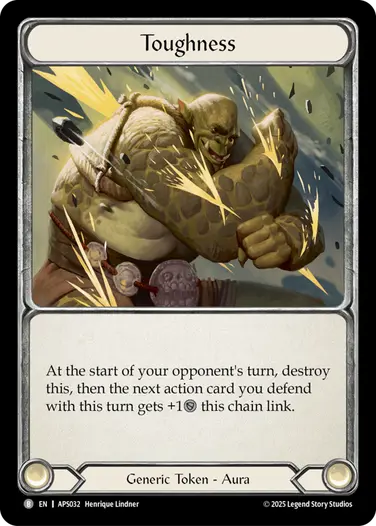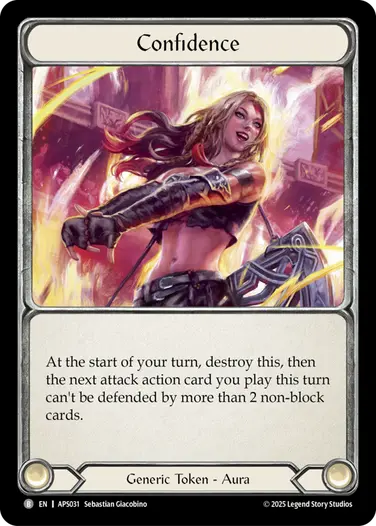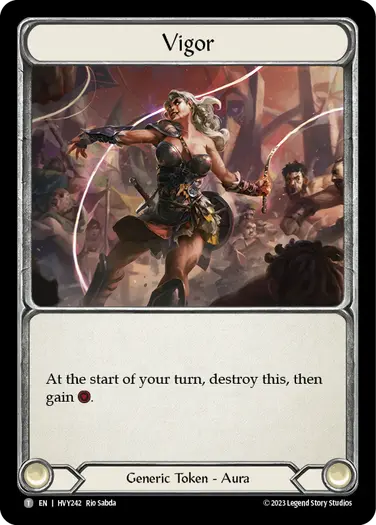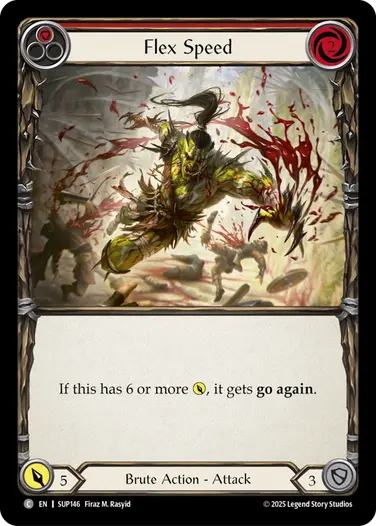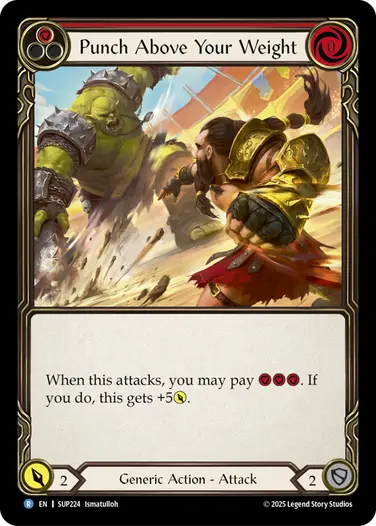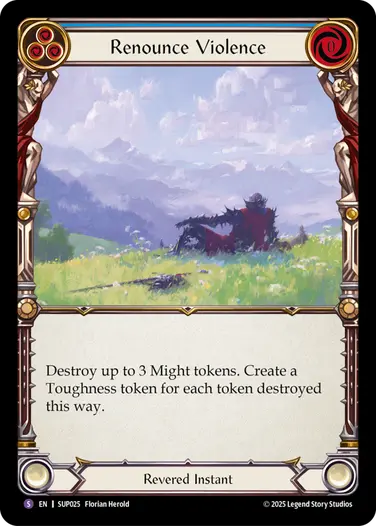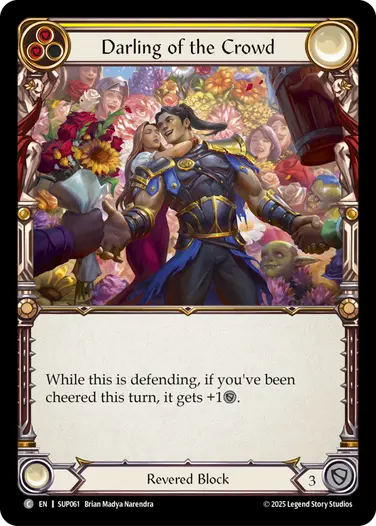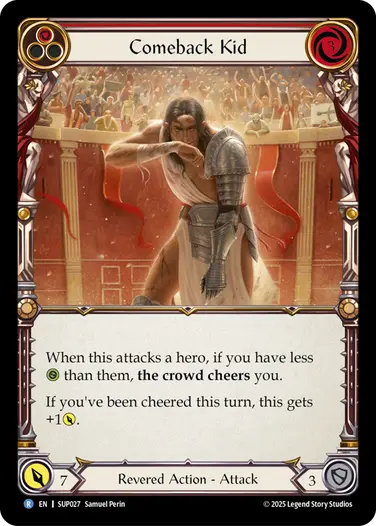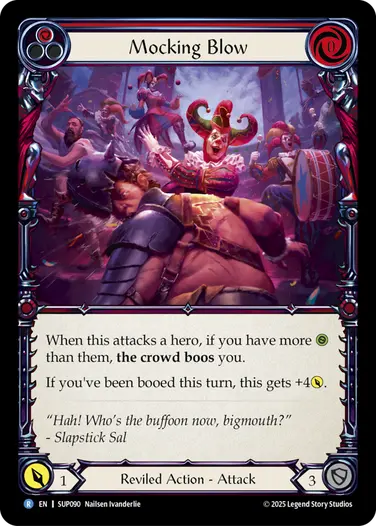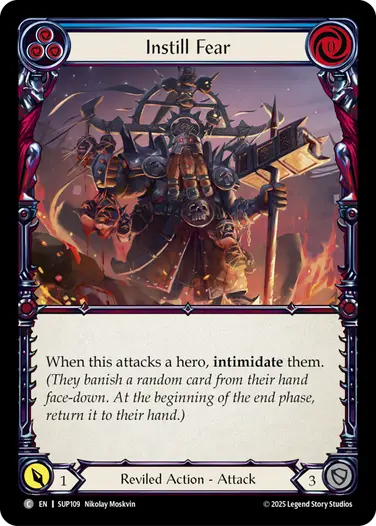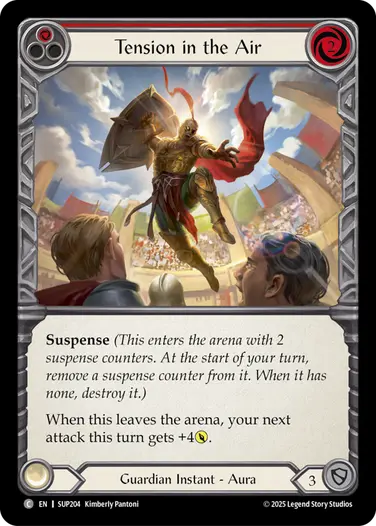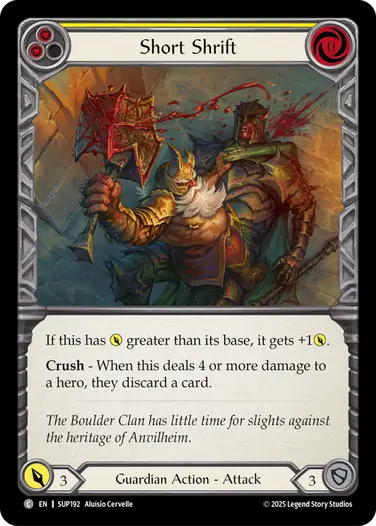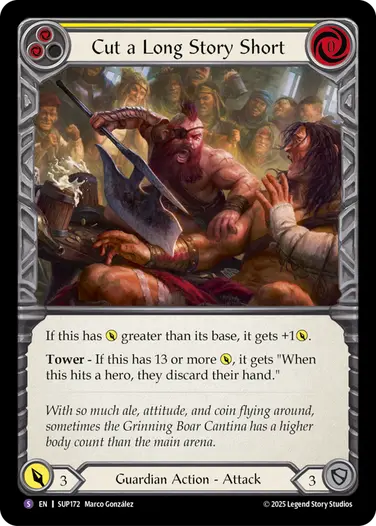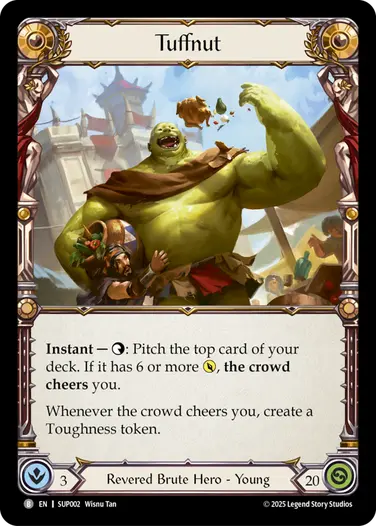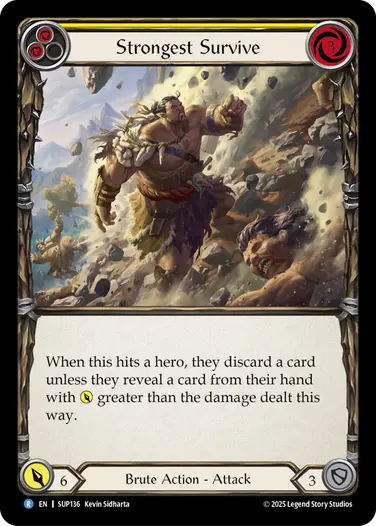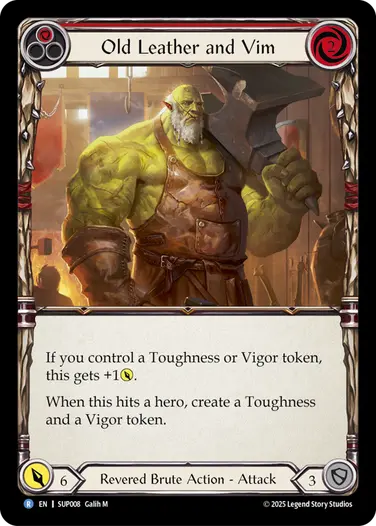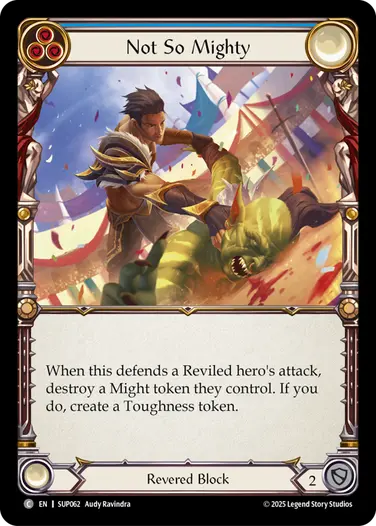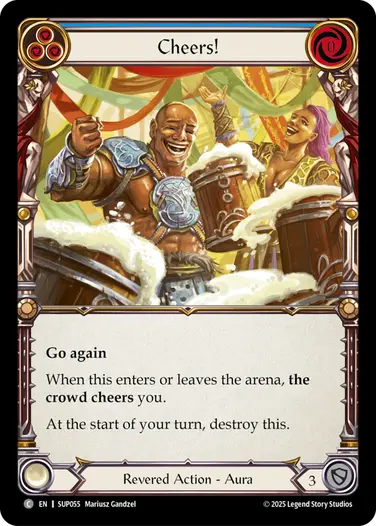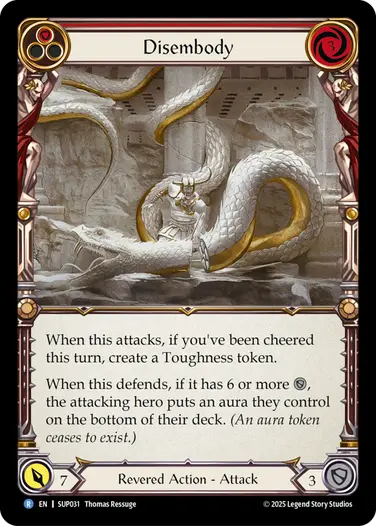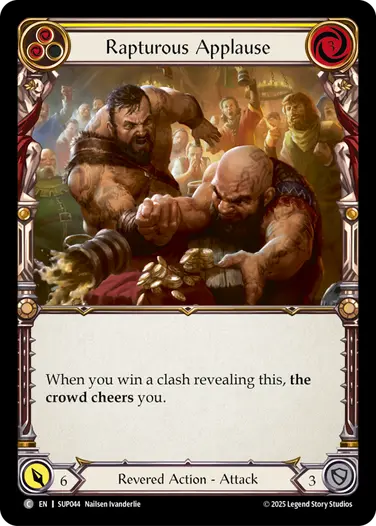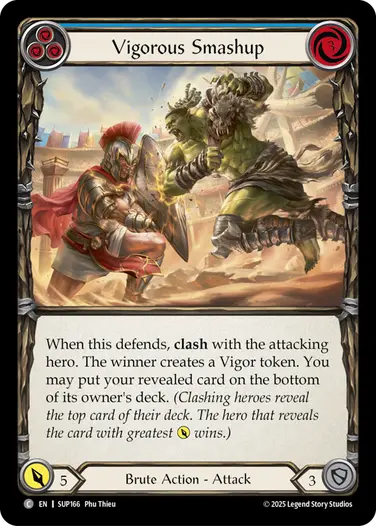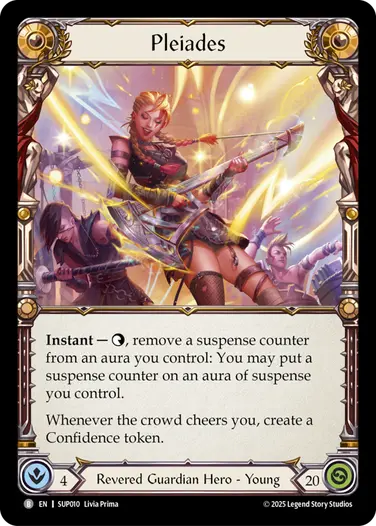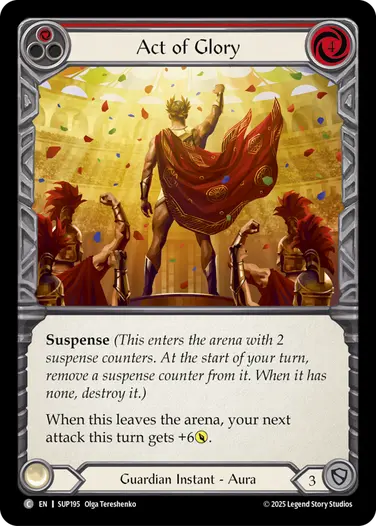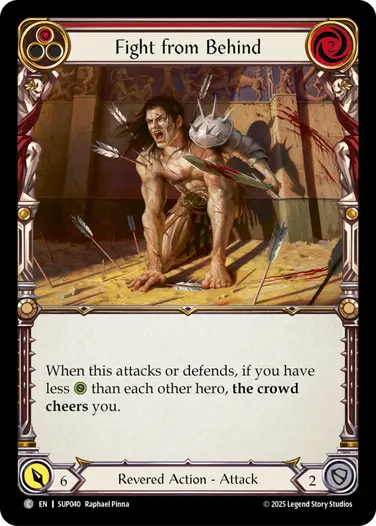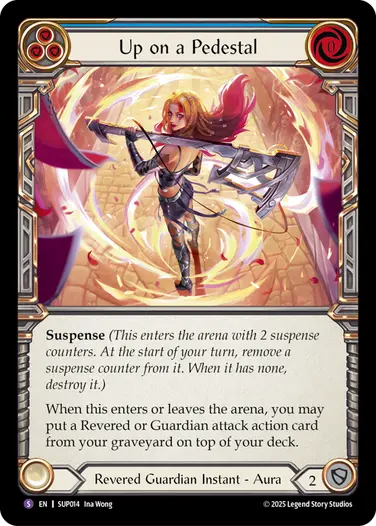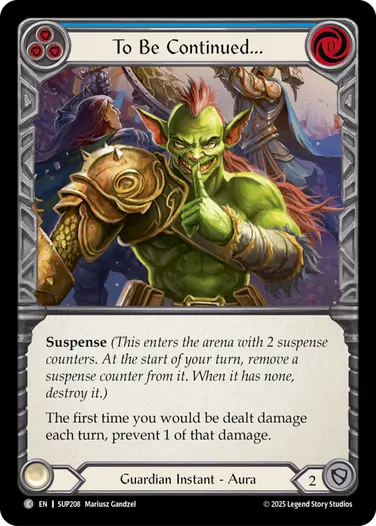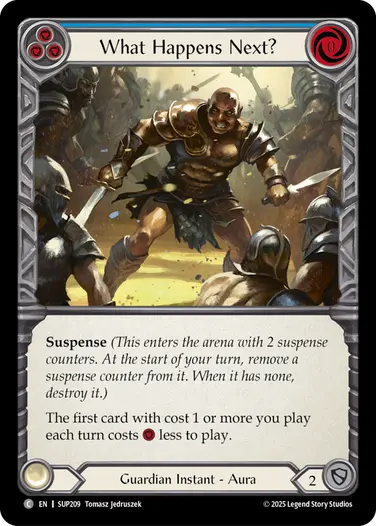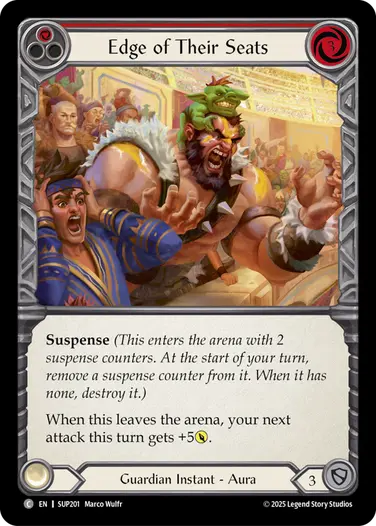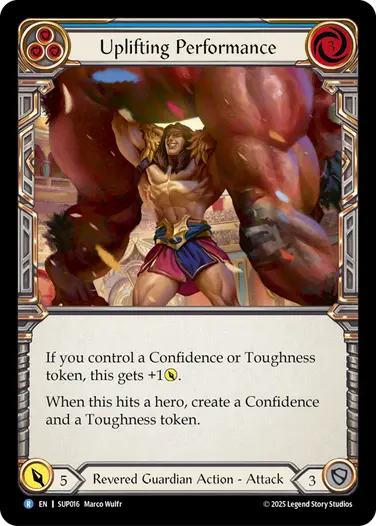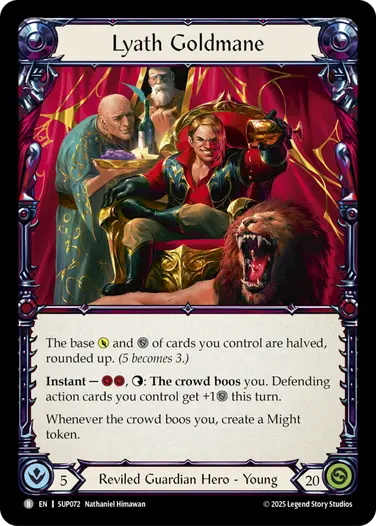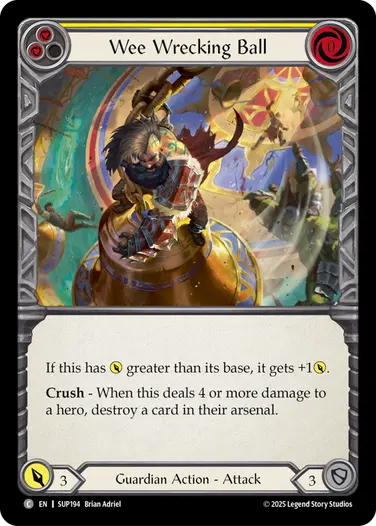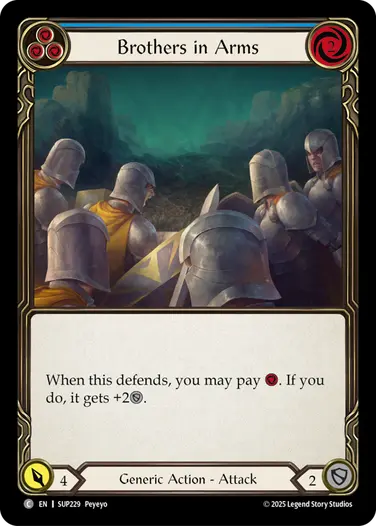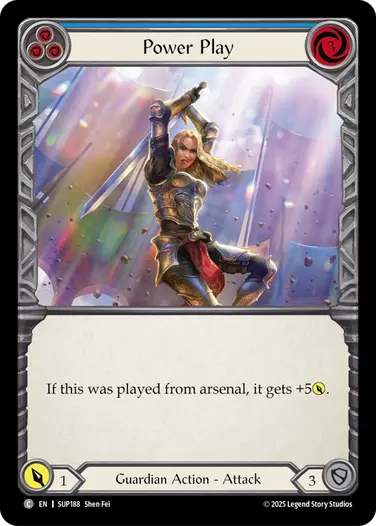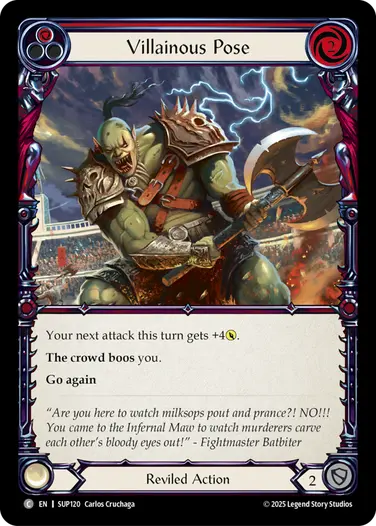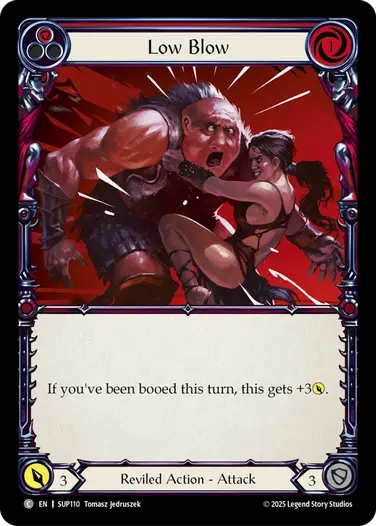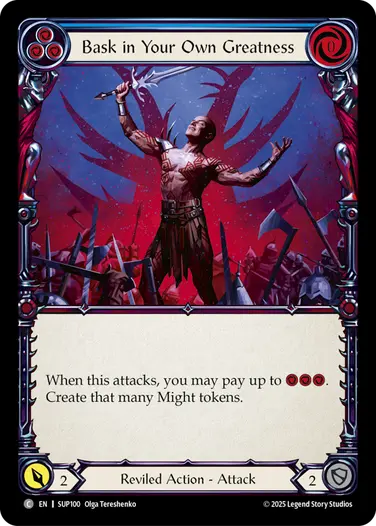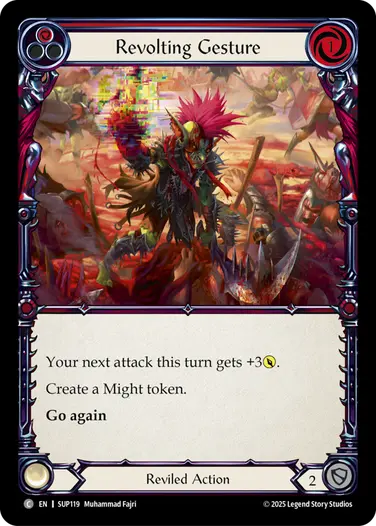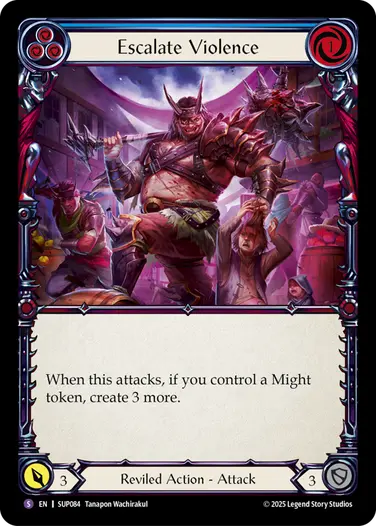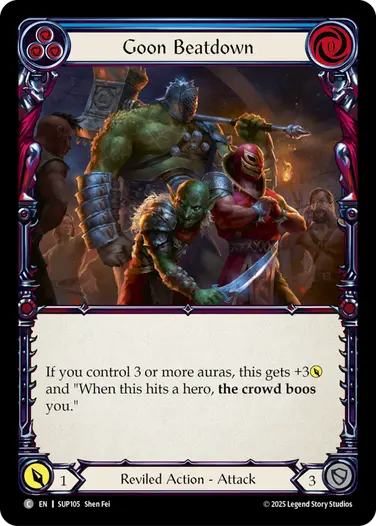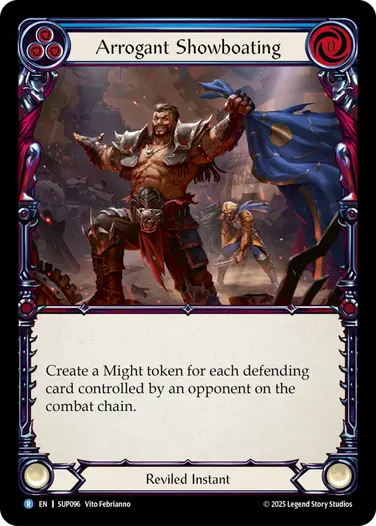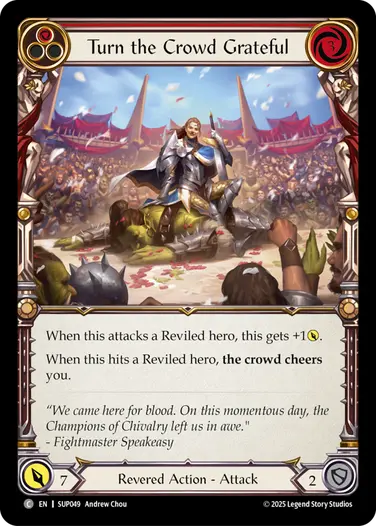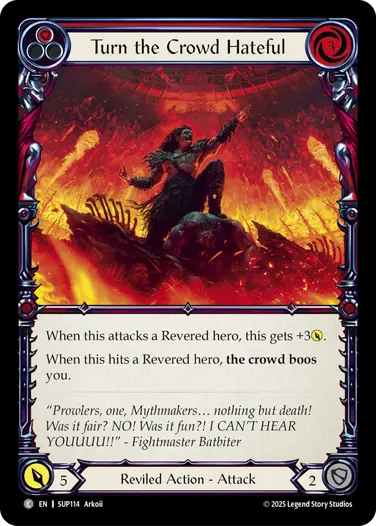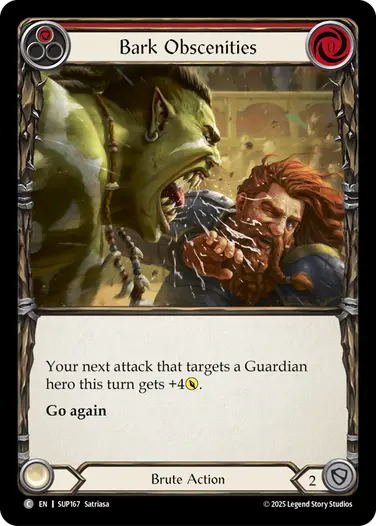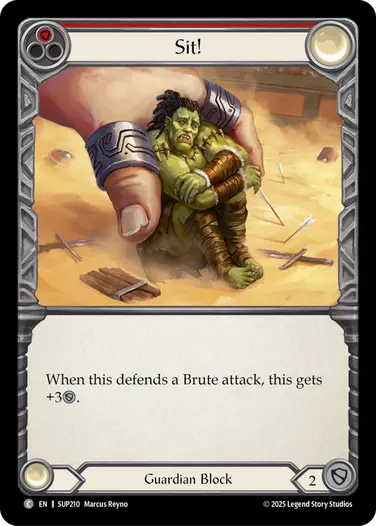💥GET IN THE RING!💥

Super Slam is the latest showtastic way to play Flesh and Blood! Choose one of four heroes - Brute or Guardian, Revered or Reviled, then enter the ring and make the crowd go wild!
Super Slam Sealed Deck uses EIGHT booster packs, with a main deck size of EXACTLY 30 cards. No more, no less. Open your packs and remove the FIRST card in each pack, which will be either a Basic card, Legendary card, Expansion Slot card, Marvel card, or Cold Foil card. Set aside any non-hero cards removed this way, as they cannot be used in your limited deck.
Next, sort your cards by class and talent, then build your deck. Note that you can also use the cards from your special promo pack in your deck. Once you’re ready, choose a hero (note that Super Slam limited is played with NO weapons), make sure you’ve got tokens handy, and prepare for the show of a lifetime!
Prime the Crowd
Before the match begins, let’s show you the ropes of the Deathmatch Arena…
Basic cards (formerly “Token cards”) are cards with the “B” rarity symbol that you always get to start with in play, such as your hero, or tokens you might create during the game, such as Might or Toughness. You do not need to open a specific Basic card in your packs in order to use it.
There are four tokens used by the heroes in Super Slam:
- Might tokens increase the power of your attacks. They are shared by Reviled heroes.
- Toughness tokens increase your defense. They are shared by Revered heroes.
- Confidence tokens make it harder for the opponent to defend. They are shared by Guardian heroes.
- Vigor tokens give you extra resources. They are shared by Brute heroes.
The symbol with an arrow in it means “tap”. To tap something, you rotate it sideways to indicate the ability has been used. All of your cards will “untap” (return to normal) at the end of your turn. You cannot tap a card if it is already tapped. Some cards will allow you to untap cards early or delay them untapping, as shown by the symbol with a reverse arrow. Only tapped cards can be untapped.
Each attack has a “base” power number, located in the bottom left of the card. Some effects can modify this number (such as Lyath or Kayo), which always happens before any power increases/decreases are added to it (such as Might tokens). Even if you modify the base power later in the turn, any increases or decreases you applied to it earlier will continue to apply to it.
Instants can be played at any time, even during the other hero's turn, and do not need an action point. Some cards are not instants, but they have “Instant —” printed in their effect text. This is an ability on the card that can be activated like an instant while you control it.
Auras stay in the arena when played or created, until an effect makes them leave. Usually auras will destroy themselves at some point to activate an effect.
Block cards do exactly what you think they do - they block! Block cards are a great way to avoid taking damage from the effect of an opponent’s Confidence token. “Blocking” is not “playing”, so be careful not to put block cards in your arsenal, as you can’t defend with cards from arsenal.
The main goal of Super Slam is to get the crowd to cheer you or boo you. There are many exciting moves in Super Slam that will cause the crowd to react, which doesn’t do anything by itself - but each hero and many of their cards will get a bonus payoff when you do!
The following keywords appear frequently in Super Slam:
Clash - both players reveal the top card of their deck to see who has the biggest power. Revealing a card with no number loses to a card with a number, even if the number is 0! Clash is commonly found on Revered cards.
Intimidate - choose a card at random from your opponent's hand and banish it face-down. They can look at it, but you can’t. They’ll get it back on their next turn, but for now, they’ve lost the option to block with it. Intimidate is commonly found on Reviled cards.
Suspense - an aura of suspense enters the arena with 2 counters (usually indicated with a dice). It loses 1 counter per turn, and usually has a powerful effect when it leaves. Make sure to check the timing of your tokens alongside your auras of suspense.
Crush - if the attack deals 4 or more damage, it has a bonus effect! It has to actually deal 4 or more damage to the opponent, not just have 4 or more attack power.
Tower - this ability only activates if you increase the power of a card to 13 or above!
Suspense, Crush, and Tower are commonly found on Guardian cards.
Tuffnut
Tuffnut is a Revered Brute. He can play Revered and Brute cards. He only has 3 Intellect, which means you only draw 3 cards per turn, instead of 4.
Tuffnut likes to defend heavily and use his hero ability every turn to pay for attacks or create Toughness tokens to survive the opponent’s attacks. Most of the time you don’t know what you’re pitching, so it pays to have a back-up plan in case you don’t end up with enough resources. (such as keeping an attack in arsenal).
Tuffnut is really good at surviving regular turns from the opponent, and he tends to run out of cards in deck slower. But you’ll need to watch out for bigger turns from the opponent that go over the top of your defense. Try to make lots of Toughness tokens when you see the opponent has a lot of Might tokens or a big aura of suspense.
When building a Tuffnut deck, look to combine a mix of 6-power cards that will trigger Tuffnut’s ability, and blue cards that will pitch for most of your attacks. Clash cards also work very well in Tuffnut, giving you Toughness, Vigor, and information about the top of your deck. Most of the cards in your deck should defend for 3.
Pleiades
Pleiades is a Revered Guardian. She can play Revered and Guardian cards. Her ability lets you change how long your auras of suspense stick around.
Pleiades likes to play lots of auras of suspense, and use them to the best advantage they can offer. Often she will try to play big beefy auras and sacrifice smaller auras to keep them around until she can get several to go off at once and unleash a massive attack in a single turn, usually alongside a Confidence token. Big plays like these are the key to getting past your opponent’s defenses and winning the game before you run out of cards.
There are a number of smaller auras that provide buffs while they hang around in the arena. All auras of suspense are instants, so you can time them whenever it is convenient, even during the opponent’s turn, or after they’ve blocked! Make sure to always think one turn ahead so you don’t mismanage your suspense counters.
When building a Pleiades deck, you’ll want 4-6 big auras of suspense, and as many little ones as you can get your hands on. You’ll want 14+ blue cards to pay for everything, and of course, a few big attacks. It’s worth holding onto an attack in your arsenal, just to be sure you have one at the ready when all your auras pop off.
Lyath Goldmane
Lyath Goldmane is a Reviled Guardian. He can play Reviled and Guardian cards. He has 5 Intellect, which means he draws 5 cards per turn, instead of 4. But it comes at the cost of his attack and defense being halved.
Lyath’s penalty may seem rough, but like a true Reviled hero, he looks to cheat big damage out of his little cards. The key is to play lots of cards that increase power, using your higher intellect to play and pitch more cards. You will need to combine a lot of specific cards at the right time for this to work, but the payoff is often huge!
Lyath also has the option to play more like a regular hero if need be. By using his ability, you can increase the defense of your action cards, and play more defensively. However, you should always be looking for ways to set up big plays, as your base aggressive power is far lower than the other heroes.
When building a Lyath deck, look for cheap attacks with 3 or less base power, as this reduces the impact of Lyath’s halving ability. You’ll also want to include lots of cards that can increase the power of your cards, including a few big auras of suspense. It might take a while to figure out how to succeed with Lyath, but here’s a helpful mantra: “Don’t play like the others - find a way to break the rules!”
Kayo, Strong-arm
Kayo, Strong-arm is a Reviled Brute. He can play Reviled and Brute cards. His ability modifies the base power of an attack, turning mediocre puny attacks into raw damage.
Kayo likes to wring the best value he possibly can out of each card. This often means playing a card with 1-2 cost and activating his hero ability, pitching two cards to pay for everything. He has a strong late game, since he can turn his pitched blues into bigger attacks. He can also play mind games with the opponent, holding a card in hand which could threaten the hero ability or be placed into arsenal.
Kayo plays really well with cards that increase power, as a lot of his cards care about having 6 or more power. His hero ability is expensive and sometimes it’s more efficient to increase the power of your attacks with Might tokens or other effects. Even though you have a strong late game, you should aim to set up big plays that can leverage both your ability and other power buffs on the same turn.
When building a Kayo deck, look for Brute cards that care about having 6 or more power, and cheap attacks with 1-2 base power. Unlike a typical Brute, Kayo is less reliant on attacks with 6 base power, which gives you room to include more blues (roughly 14+) to reliably pay for your ability. Among your blue cards should be some that are good to arsenal in case the opponent over-defends.
Inventory
If you’re struggling to work out your final few cards, it’s actually often better to build a 27-28 card deck, then wait to see which hero your next opponent is playing before deciding what remaining cards to bring in to complete your 30-card deck. All the cards you opened in your packs become part of your inventory, and you can swap them in and out between rounds.
For this reason, it’s a good idea when deck-building to sort any cards that target specific classes or talents into a separate pile. Then, each round you can complete your deck with cards from this “sideboard” pile depending on which hero you’re facing. Just make sure each game you present exactly 30 cards!
